Asus ZenScreen MB16QHG review: A pricey but alluring portable monitor
Expert’s Rating
Pros
- Useful kickstand with tripod mount
- Excellent brightness
- Good color performance
- 120Hz provides better motion clarity
Cons
- Build quality doesn’t impress
- Contrast ratio falls short of OLED
- Not the best value
Our Verdict
The Asus ZenScreen MB16QHG delivers a bright, vibrant image and plentiful features, but its price feels steep next to OLED alternatives.
Best Prices Today: Asus ZenScreen MB16QHG
A portable monitor is an excellent travel companion and ideal second monitor for cramped work-from-home setups, but the image quality of budget models can leave something to be desired. Asus ZenScreen MB16QHG provides an upgraded experience with superior brightness, contrast, and color performance—but the upgrades don’t come cheap.
Further reading: See our roundup of the best portable monitors to learn about competing products.
Asus ZenScreen MB16QHG specs
The Asus ZenScreen MB16QHG is a bit different from most portable monitors available today. It has a 16-inch 16:10 display panel, instead of a 15.6-inch 16:9, and a resolution of 2560×1600. Asus also upgrades the refresh rate to 120Hz.
- Display size: 16-inch 16:10 widescreen
- Native resolution: 2560×1600
- Panel type: IPS LCD
- Refresh rate: 120Hz
- Adaptive Sync: None
- HDR: Yes, VESA DisplayHDR 400 certified
- Ports: 1x HDMI 2.0, 2x USB-C with DisplayPort Alternate Mode, earphone-out jack
- VESA mount: None, tripod mount available
- Speakers: None
- Price: $399
The Asus ZenScreen MB16QHG will retail at $399, which feels steep for a portable monitor that lacks an OLED panel. Shoppers may compare it side-by-side with Viewsonic’s ColorPro VP16-OLED, which typically retails for $399 online.
Asus ZenScreen MB16QHG design
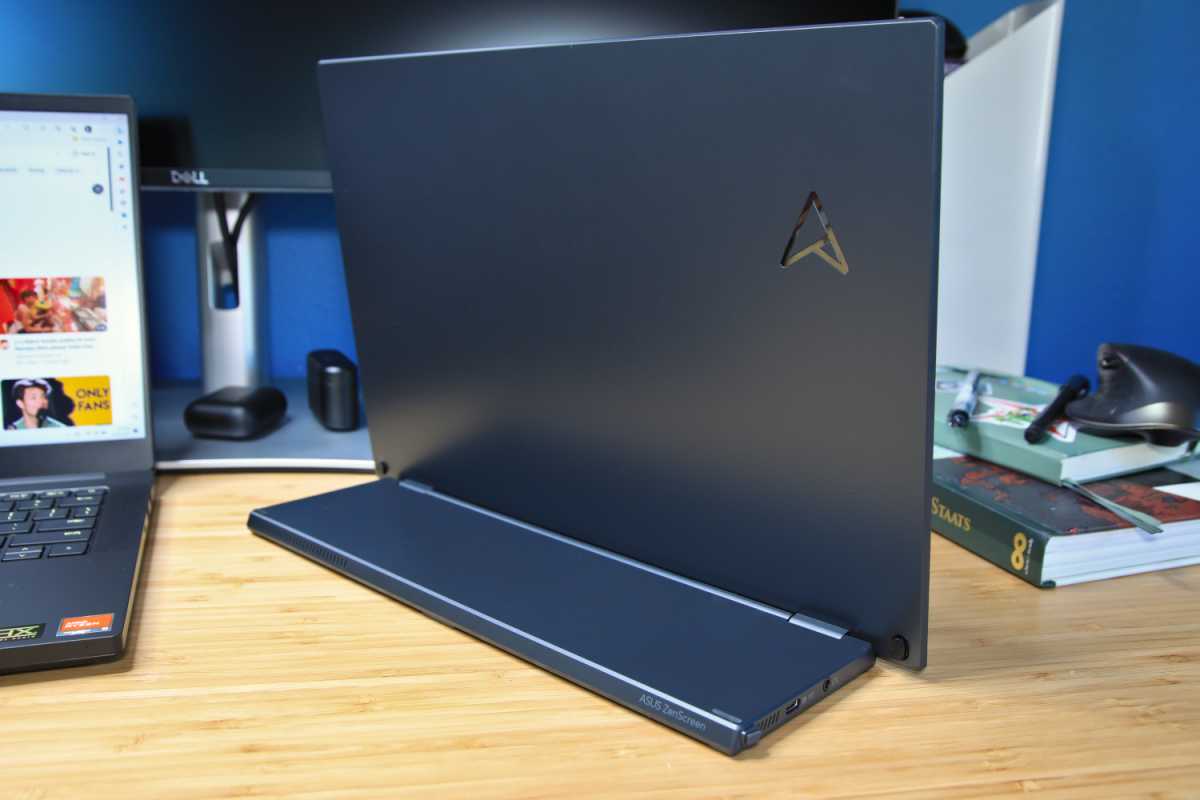
The Asus ZenScreen MB16QHG comes with a well-designed and convenient stand.
Matt Smith
The Asus ZenScreen MB16QHG’s kickstand sets it apart from most portable monitors. The stand folds down from the bottom of the monitor and ends up sitting flat on a desk or table. It’s somewhat similar to the Viewsonic ColorPro VP16-OLED but, unlike that alternative, Asus’ stand doesn’t increase the height of the monitor. The stand design is stable and allows for a wider range of tilt adjustment than most portable monitors. It also supports use in portrait orientation.
Photo and video editors who want to preview their work will appreciate the monitor’s tripod stand, which lurks on the bottom of the kickstand. Unlike many portable monitors, Asus’ stand doesn’t double as a protective display cover, but Asus includes a protective carrying case.
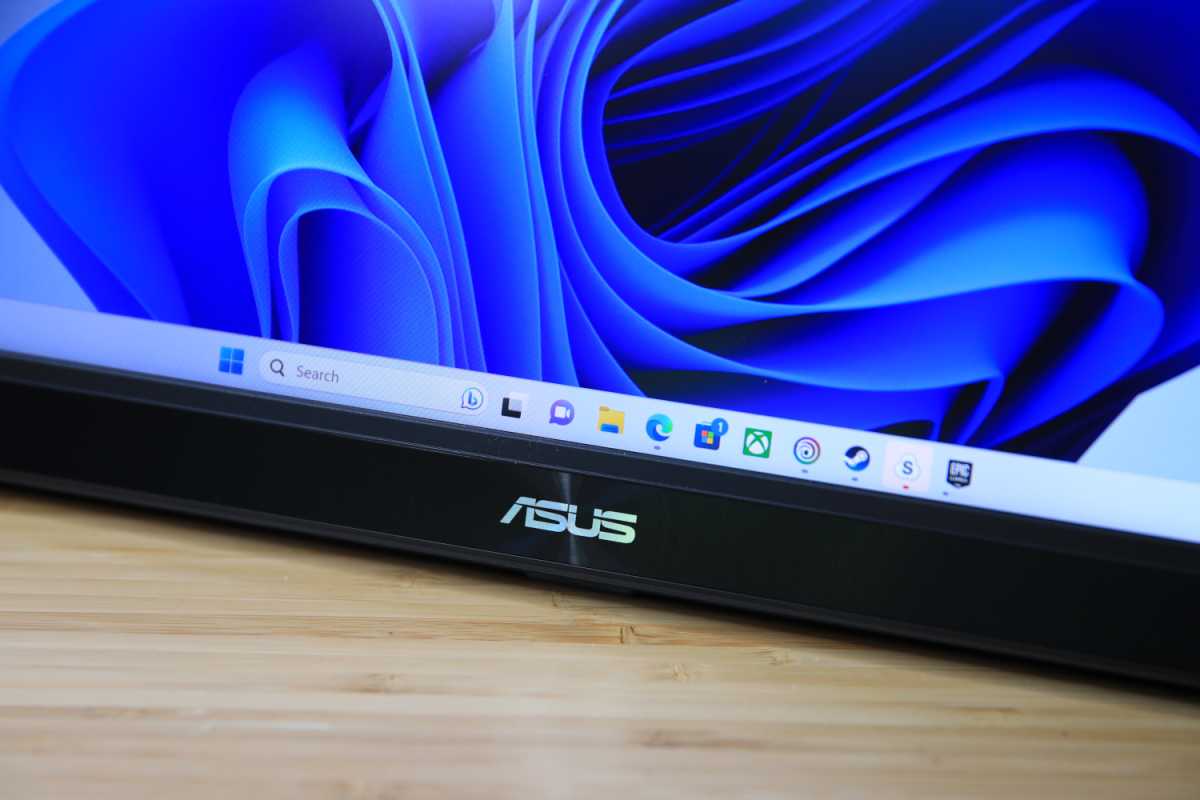
A basic plastic bezel surrounds the Asus ZenScreen MB16QHG.
Matt Smith
The monitor’s form is a bit less impressive than its function. Plastic dominates the chassis, and its rigidity is no better than alternatives sold for half the price. A decorative lip on the lower bezel offers a bit of flair, but it’s glossy and may cause glare in bright rooms. I expect better at this price.
Asus ZenScreen MB16QHG features and menus
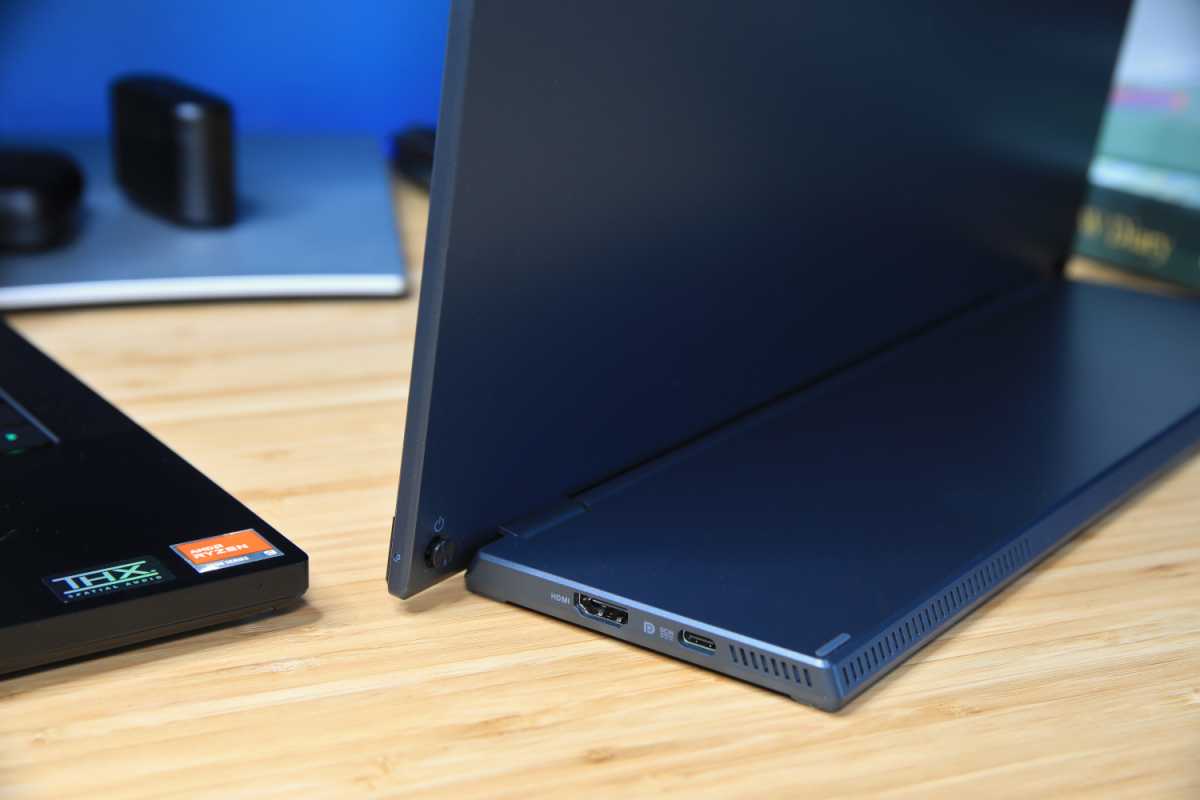
Asus ZenScreen MB16QHG connectivity features.
Matt Smith
Connectivity includes one full-sized HDMI 2.0 port and two USB-C ports with DisplayPort Alternate mode. The USB-C ports power the monitor from either a connected device or the included USB-C power brick. A 3.5mm audio-out jack rounds out the options.
The ports are typical for a portable monitor, with one exception: the full-sized HDMI port. Many competitors, especially those which are less expensive, use a Mini or Micro-HDMI port. That means you’ll need an appropriate cable to connect to the monitor. It’s not a huge issue, but a full-size HDMI port makes connecting a tad easier.
The MB16QHG can handle many photography, videography, and digital art workflows, and looks attractive when it’s time to kick back and enjoy a game or Netflix.
Asus exceeds expectations with the monitor’s on-screen menu system, which provides a wider variety of options than most portable monitors. A quick, responsive joystick on the monitor’s right flank is used to navigate the menus.
Asus provides numerous image-quality modes and adjustments for color, saturation, and color temperature, although some of these settings are only available in specific image-quality modes. Still, Asus’ menu system far exceeds budget monitors like the Arzopa A1 Gamut and comes close to the more expensive Viewsonic VP16-OLED.
Speakers aren’t included. Most portable monitors include speakers, but the quality is inevitably disappointing. I don’t think Asus’ decision to ditch them is a problem.
How is the Asus ZenScreen MB16QHG’s SDR image quality?
The Asus ZenScreen MB16QHG is geared towards professionals who frequently travel, but its image quality actually exceeds their needs. It provides a bright, crisp image with good color performance. The monitor can handle many photography, videography, and digital art workflows, and looks attractive when it’s time to kick back and enjoy a game or Netflix.

Matt Smith
Brightness ranks among the monitor’s strongest qualities, with a maximum brightness of 479 nits in SDR. As the graph shows, that’s higher than any portable monitor we’ve tested this year.
It’s not a trivial advantage. Portable monitors are more likely to be used in situations where light control isn’t available. The MB16QHG’s brightness will make it more comfortable to use in these situations.

Matt Smith
Contrast is decent, though the MB16QHG’s performance depends on your perspective. It’s superior to other portable monitors with an IPS LCD panel, such as the Azorpa A1 Gamut and AOC I1601FWUX. But OLED portable monitors, such as the ViewSonic ColorPro VP-16 OLED and the Innocn 15K1F, provide a better sense of depth and dimensionality.
The degree to which this matters depends on your use. The MB16QHG looks great when displaying bright, colorful content, as this obscures its relatively weak contrast. OLED, which can dim each pixel individually, is a better choice if you enjoy, or work with, darker images, games, and films.
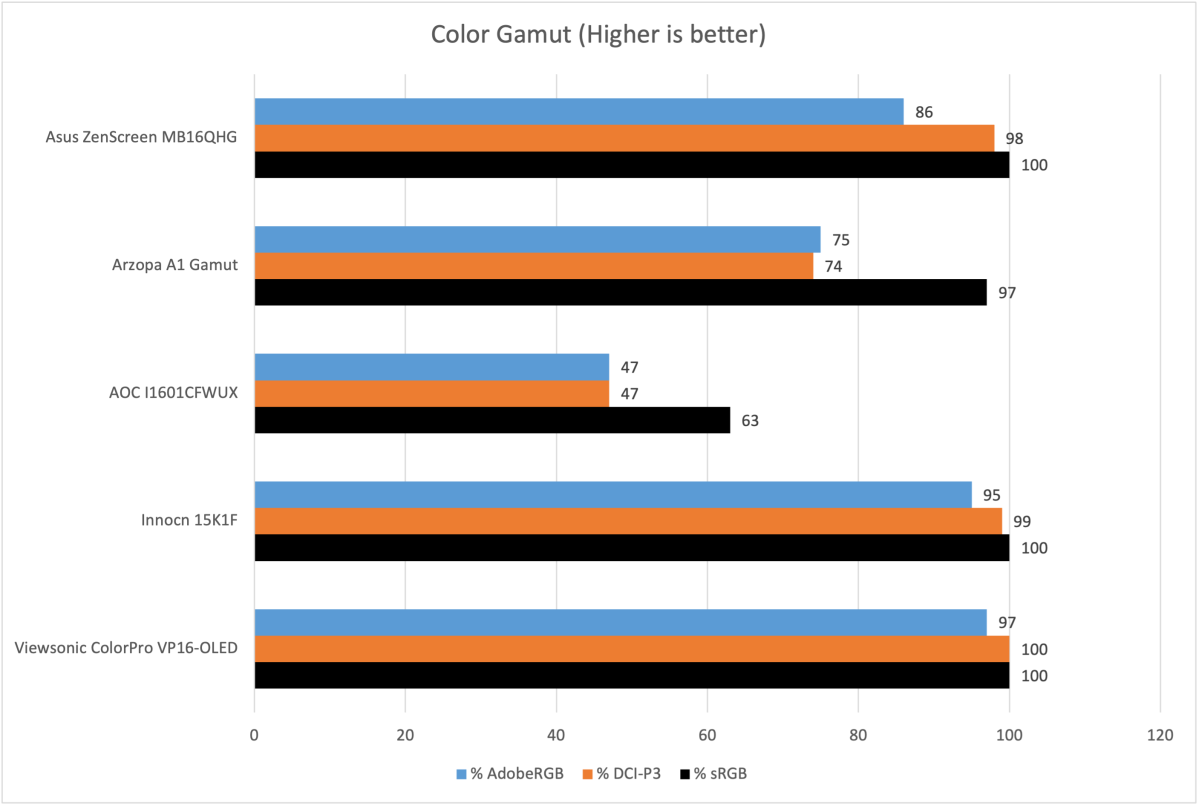
Matt Smith
It’s a similar story in color gamut. The MB16QHG compares well to other IPS LCD monitors, but not as well against OLED alternatives. Still, the MB16QHG manages to display an impressive 98 percent of the DCI-P3 color gamut, which is enough for most professional photography and videography.
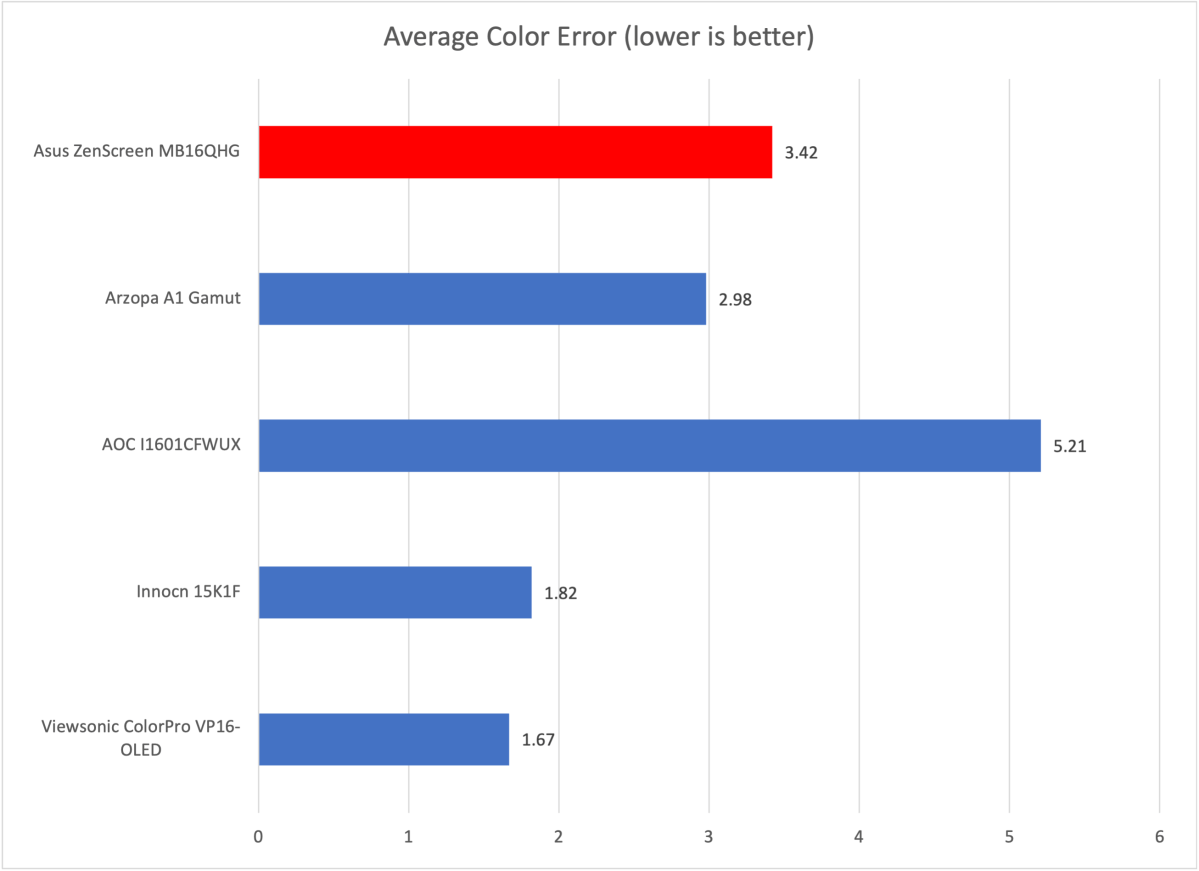
Matt Smith
Color accuracy is complex, as the MB16QHG is merely okay at default settings. It looks attractive, but testing revealed colors were blown out and overly vibrant. The problem is an unfortunate choice of default color mode. The monitor ships in Scenery mode, which ups the color saturation to an unrealistic level.
Fortunately, the monitor’s color accuracy is improved in other modes (Standard Mode provides an average color error of just 1.46), and the menu system offers plenty of opportunities for calibration.
The monitor does well in color temperature and gamma with a reading of 6500K and 2.2 respectively. Both readings are precisely on our preferred targets. They indicate the monitor’s image looks realistic and that content is roughly as bright as its creator intended.
Sharpness is another perk, as the monitor provides a resolution of 2560×1600. That works out to a pixel density of roughly 188 pixels per inch—higher than a 27-inch 4K monitor. Small fonts look crisp and high-resolution video reveals plenty of detail.
The Asus ZenScreen MB16QHG isn’t the most attractive portable monitor around—that honor goes to its OLED competitors—but it earns high marks in brightness, color performance, and sharpness.
How is the Asus ZenScreen MB16QHG’s HDR image quality?
The Asus ZenScreen MB16QHG supports HDR input and carries VESA DisplayHDR 400 certification. That might sound promising, but HDR performance doesn’t hold up.
Brightness is a problem. The monitor approaches 500 nits in HDR, but that’s still not enough to deliver a quality HDR experience. Complex high-contrast scenes, like the black hole from Interstellar, show that a lot of luminance detail is crushed. Bright areas of a scene appear as a uniform, bright glow that lacks detail. This occurs in part because the monitor isn’t bright enough to make the brightest portions of the scene distinct.
The monitor’s HDR support is a perk if you need to view an HDR video or image but lack a laptop with HDR support. Just keep your expectations in check.
How is the Asus ZenScreen MB16QHG’s motion performance?
Surprisingly, the Asus ZenScreen MB16QHG delivers a refresh rate of 120Hz. That’s comparable to many portable monitors meant for gamers. The enhanced refresh rate improves motion fluidity and clarity in games, but also proves useful when scrolling through text or images.
Gamers shouldn’t get too excited, however, as the monitor sadly lacks Adaptive Sync support. Its absence allows screen tearing in games which don’t produce a frame rate equal or above the monitor’s 120Hz. To be fair, though, many portable gaming monitors also lack Adaptive Sync, so the MB16QHG isn’t at a disadvantage.
Is the Asus ZenScreen MB16QHG worth it?
The Asus ZenScreen MB16QHG is a versatile portable monitor for productivity, general use, gaming, and most content creation. The monitor’s IPS panel can’t compare to OLED portable monitors, however—a problem, as the MB16QHG is priced to compete with them. Asus strikes back with superior sharpness (most OLED alternatives are 1080p) and a 120Hz refresh rate. I think OLED is better for most people, but the MB16QHG is a solid pick if you need a portable monitor that’s brighter, and sharper, than OLED provides.
For all the latest Technology News Click Here
For the latest news and updates, follow us on Google News.

